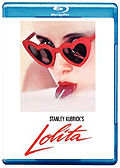Stanley Kubrick, Part I
 Truth be told, the first time I’d seen Lolita (1962), I was bored, but that was perhaps 20 years ago, and as happens with one’s taste in music, things change, or rather one develops an appreciation for different directors and their career phases.
Truth be told, the first time I’d seen Lolita (1962), I was bored, but that was perhaps 20 years ago, and as happens with one’s taste in music, things change, or rather one develops an appreciation for different directors and their career phases.
Uwe Boll is still a lower-tier Ed Wood, hence I’ve no desire to revisit his rabbit rubbish, but Stanley Kubrick was cut from a different cloth (duh), and perhaps the most popular adjectives applied by critics and non-fans towards this American icon is cold, dry, eccentric, weird, reclusive, and perhaps a little mad.
One quality few seem to get off the bat is how funny Kubrick was, particularly in his later work. The last line in Eyes Wide Shut (1999), his final film, makes it clear the story you just watched was a funny – not unlike the moment in David Fincher’s The Game (1997) where a certain character realizes everything that’s been driving him to the brink of madness was rooted in something… funny.
In the case of EWS, it seemed to take punchline to make it clear you just saw a darkly comedic film about obsessions, repressions, marital bickering, and weird characters that fade in and out of dark store corners.
Even Full Metal Jacket (1987) was satirical, and Warner Bros. actually sold the film based on fast clips in the trailer, and one character (dubbed “Joker” by his men) uttering the phrase ‘Sir… Does this mean that Ann-Margret’s not coming?’
But one has to step back another 25 years to see where Kubrick found a project in which he could loosen up and allow his dry, satirical wit to permeate elements in each shot.
Lore has it that Kubrick rewrote much of Vladimir Nabokov’s own script, and while there are peculiar moments of slapstick in Lolita – notably Humbert Humbert trying to unfold a cot while Lolita sleeps soundly in the hotel big bed – Kubrick satirizes bad behaviour and overall wrongness by pitching the dialogue, the performances, and long takes just high enough to make the ugliness of a professor sleeping with a teenager ridiculous – an amazing accomplishment when there’s plenty of patently offensive behaviour throughout the film.
As the evil Quilty who torments Humbert from a safe distance, Peter Sellers augurs the film with his accents and impersonations, but even with another actor in place of Sellers, the film would’ve conformed to Kubrick’s sense of the absurd, because Lolita is a forerunner to the more outrageous behaviour in Dr. Strangelove (1964), which he co-authored with madman Terry Southern.
Warner Home Video recently issued Lolita and Barry Lyndon (1975) on Blu-ray – two dryly funny satires that offer unique rewards to devoted Kubrick fans, as well as sophisticates wanting literary absurdism perfectly distilled into sound + image – and I’m paring the reviews with some related materials.
In Part I, in addition to Lolita [M] (WHV), I’ve also chosen to focus on Kubrick’s earliest work: his documentary shorts. His three films ought to have been packaged in a single DVD set years ago, but that’s never happened – either because of rights issues, or Kubrick feeling his nascent filmic efforts, like his feature film debut Fear and Desire (1953), were too immature to remain in circulation.
His first two shorts (both made in 1951) were sold to RKO as newsreels, and they’ve popped up in various places on TV. Day of the Fight [M] has been broadcast on TCM, European TV (BBC, RAI) and is available via Archive.org, whereas Flying Padre [M] has received less airplay.
 The Seafarers [M] (1953) did the rounds on YouTube, but its rights were recently re-acquired, and a special edition DVD emerged in 2008 with extras, including an audio commentary track with directors Keith David and Roger Avary.
The Seafarers [M] (1953) did the rounds on YouTube, but its rights were recently re-acquired, and a special edition DVD emerged in 2008 with extras, including an audio commentary track with directors Keith David and Roger Avary.
Seafarers was Kubrick’s first colour film, but he didn’t return to colour until Kirk Douglas nabbed him to direct Spartacus (1960) after director Anthony Mann was dismissed. Between 1951 – 1960, Kubrick’s films were dramas, anti-war statements, noir, and documentaries, but it wasn’t until Lolita that he found his groove, and slowly developed his mid- and late-career style of satire, drama, and commentary.
2001: A Space Odyssey (1968) was a unique exception, whereas The Shining (1980) plays with varying aspects of spousal violence and madness. I still think Stephen King, in his original assessment of the film, felt Kubrick didn’t quite understand the machinations of a horror story; perhaps the striking sequences were designed to be nightmarish extensions of seething violent tendencies, and as was Kubrick’s desire to let audiences make the final judgment, have them similarly figure out what the puzzle bits mean when examined by each subjective viewer.
In Part II, I’ll have reviews of Barry Lyndon, plus the teasing BBC documentary Stanley Kubrick’s Boxes (2008).
.
.
Mark R. Hasan, Editor
KQEK.com
Category: EDITOR'S BLOG, FILM REVIEWS





Connect
Connect with us on the following social media platforms.